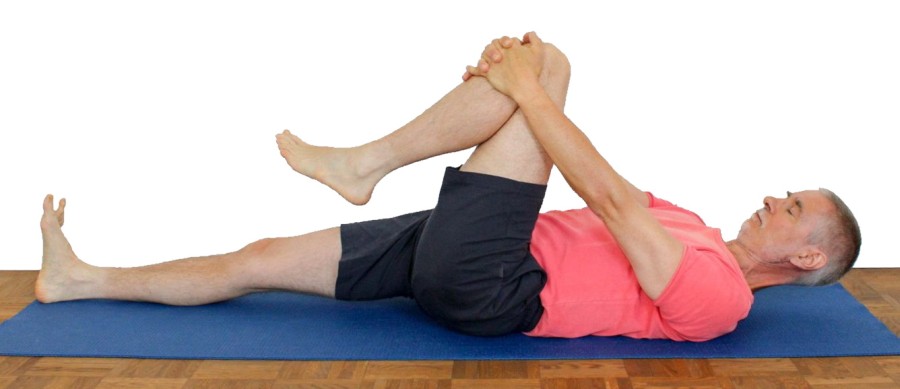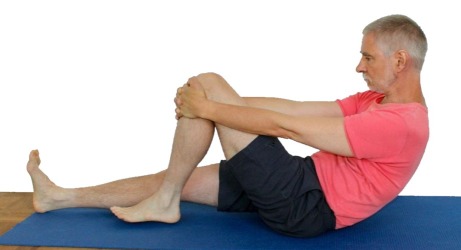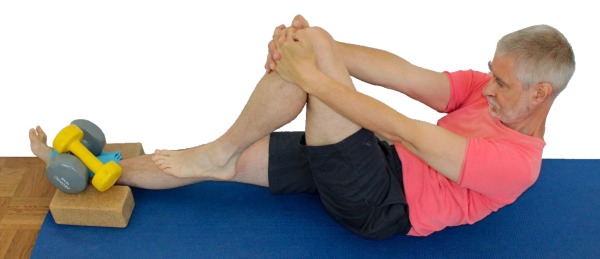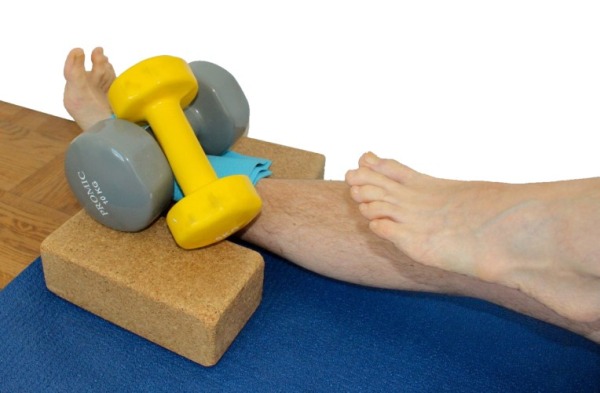yogabook / functional exercises / roll up the back
Contents
„roll up the back“

 instructions and details with working links as PDF for download/print
instructions and details with working links as PDF for download/print
Detailfotos
Starting position | End position |
Feedback: We would love to hear what you think about this description, give us feedback at:
postmeister@yogabook.org
last update: 12/30/2018
Name:
Trivia name: Roll up your back
Level: A
- Classification: A
- Contraindication
- Effects of
- Preparation
- follow-up
- derived asanas
- similar asanas
- diagnostics
- Instruction
- details
- Variants
Classification
classic: functional exercise
psychomental:
physiological: stretching (lumbar spine)
Contraindication
Postures and movements that convexly round(flex) the spine are contraindicated in acute disc problems in the lumbar spine and can cause pain and have a detrimental effect on the alleviation of symptoms; this posture is therefore contraindicated until further notice, even if the moments occurring in the vertebral segments are not as great as in parsvottanasana, for example. For the latter reason, this pose can still be tried under therapeutic supervision if, in addition to the disc problem in the lumbar spine, there is also painful hypertonicity in the lumbar spine or lumbago that needs to be alleviated. In the case of disc problems in the cervical spine, the head must of course not be moved towards the sternum, but the cervical spine must be kept straight, which is likely to worsen the statics of the posture to such an extent that only the exercises with a barbell and with support can be performed.
Effects
- (551) Stretching the quadratus lumborum
- (641) Stretching the muscles of the lumbar spine
Preparation
The inability to extend the hips or an excessive hollow back with the leg stretched out on the floor in this posture indicates shortened hip flexors. This is often associated with excessive tension in the autochthonous muscles in the lumbar spine. It is then rather unlikely that the upper body can be successively lifted off the floor vertebra by vertebra because the physiological lordosis cannot be reversed or even hyperlordosis remains. In these cases, the mass distribution cannot become favorable enough to prevent the leg lying on the floor from lifting off. For the risks of a hollow back, see the FAQ The following preparations are then helpful:
- hip opener 1
- hip opener 2
- Warrior position I
- upface dog
- urdhva dhanurasana (back arch)
- ustrasana (camel)
and other backbends with extension in the hip joint.
Follow-up
If hyperkyphosis of the thoracic spine is present, it may be necessary in some cases to extend the thoracic spine in order to restore a balanced feeling in the back.
derived asanas:
similar asanas:
Diagnostics (No.)
Variants:
Instruction
- Lie on your back.
- Bend the left leg and grasp the lower leg near the knee with both hands, keeping the arms straight.
- Raise your head and slowly pull your upper body upwards, vertebra by vertebra, with your bent leg on the long arm, rounding the spine as much as possible.
- When the most difficult point has been overcome, or the pelvis has exceeded an angle of approx. 60° to the floor, slowly lower the upper body again by the long arm until the whole back is laid down.
- Repeat this, if possible, until the back can be rolled up and lowered without jerking or feeling a step.
Details
- When the back is rolled up, the lumbar spine becomes convex against its natural lordosis. This, together with a greater than normal flexion of the thoracic spine and the cervical spine, which is also flexed, causes the gravity plumb line to be moved beyond the ischial tuberosities towards the thighs so that the legs can remain on the floor when attempting to lift the upper body instead of the legs being lifted and the upper body remaining on the floor, as would be the case if the gravity perpendicular were on the head side of the ischial tuberosities. In cases of a less mobile thoracic spine, but especially a less mobile lumbar spine, this favorable shift in the center of gravitydoes not occur and the upper body cannot be lifted. In other cases, the lumbar spine is so immobile that it cannot be bent clearly in a convex(kyphotic) direction and when the upper body is raised, a step is created that can only be overcome with momentum, which manifests itself as a gradual plopping down when the upper body is lowered, i.e. no uniform speed and no reversibility is possible.
- This exercise serves both as a test or control of flexibility, especially of the lumbar spine, and its improved flexibility.
- It is often observed that complaints in the lower back are associated with overstretching or a lack of flexibility in the lumbar spine in the convex direction. In these cases, consecutive damage to the intervertebral discs of the lumbar spine and a reduced buffering effect of the spine and increased compression in lumbar spine-kyphotic postures should also be considered. It is not uncommon for acute complaints to improve as the lumbar spine becomes more flexible in the direction of kyphosis and reduction of hypertonicity, although this is not to say that this is the only sensible therapeutic measure. This requires, among other things, an examination of the extent of muscular imbalances and, if necessary, imaging to identify non-muscular damage. A lack of flexibility is often caused by a hollow back, often due to significantly shortened hip flexors, often without sufficient postural awareness, as well as repeated activities in non-physiological postures with an excessively lordotic lumbar spine.
- If this exercise cannot be performed at first or cannot be performed without a step, the extended leg can be fixed in place with a supporter or an object.
- Keep the arms stretched instead of bending them. Do not use the abdominal muscles to lift the upper body. The upper body should be lifted solely by reducing the flexion in the hip joint of the bent leg and thus using the strength of the relevant extensors of the hip joint.
Variants
holding on, with dumbbell

Detail photos
Secure against rolling away, patch against pressure |
Instructions
- Take the pose described above, but proceed as follows to prevent the foot from lifting:
- Place a block to the left and right of the ankle of the leg remaining on the ground.
- Place a piece of blanket or a few patches on top of the ankle and one part of the lower leg as a softener.
- Place a sufficiently heavy dumbbell (usually 10 kg is sufficient) across the ankle on the two blocks.
- Start to roll your back up and down as described.
Details
- If the dumbbell is placed too far towards the back of the foot, the inclined foot can cause the dumbbell to roll off the blocks and onto the front leg in an inclined position.
- Dumbbells with an octagonal profile are more suitable as they do not roll as quickly.
- A patch can be clamped under the dumbbell on the pelvic side to prevent it from rolling away.
- If the lumbar spine is not sufficiently flexible, this should be practiced repeatedly until the lumbar spine is flexible in the convex direction. Later, it should be tested again and again in loose succession to see whether the improved flexibility has not been lost again and if it has, it should be reworked. Everyday postures, physical work, sport and the somatization of inner tension often increase the tension in the back muscles.
- Instead of a dumbbell, any object can be used that is suitable for preventing the heel of the outstretched leg from lifting off the floor. This could be the strut of a sufficiently heavy chair, a bed or a couch.
(P) Holding the foot

Instruction
- Adopt the stance as described above, but proceed as follows to prevent the foot from lifting off the ground:
- The supporter stands or sits next to the lower leg of the leg remaining on the ground and places one foot on the distal end of the lower leg so that this leg does not lift off the ground.
Details
- This variation basically does the same as the variation with a barbell, but the supporter can feel how much pressure is needed to keep the heel of the extended leg on the floor. The supporter can also suspend the support as a test to see how far the performer can manage the posture on their own.
